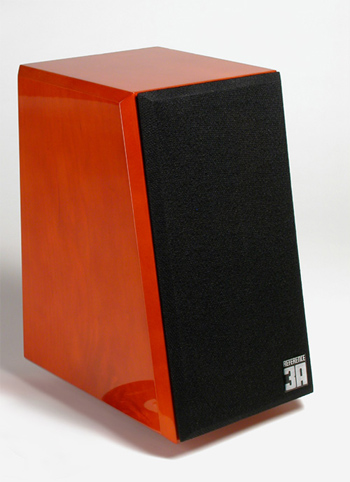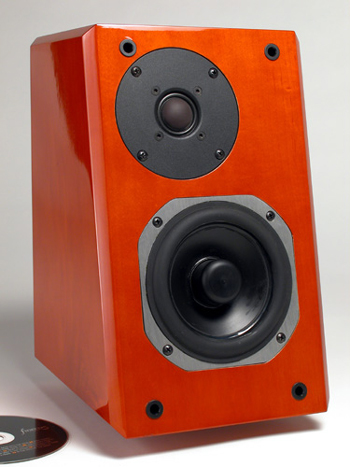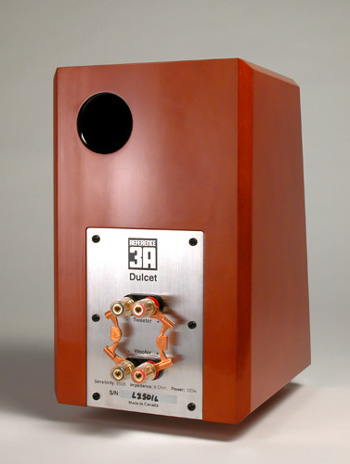You are reading the older HTML site
Positive Feedback ISSUE
15
september/october 2004
reference 3a
Dulcet loudspeakers
as reviewed by John T. Brazier

|
JOHN BRAZIER'S SYSTEM
LOUDSPEAKERS
ELECTRONICS
SOURCES
CABLES
|
I first became aware of Reference 3A, I wasn't sure what my conversational counterpart was referring to—"I love my Reference 3As," he said, but I didn't know whether this was a company, a model number, or something else. Not eager to divulge my ignorance, I nodded approvingly and moved the conversation on. This was about five years ago, and the internet was not as accessible to me as it is now. I heard the name here and there after that. While on an audio-shop safari in Kansas City, Missouri, I ventured into a very eclectic shop called Primus Audio that had a pair of L'integrals, the floorstanding entry from Divergent Technologies and their speaker company, Reference 3A. I was impressed by the smooth and refined sound of the L'integrals, but don't recall having another meaningful encounter with Reference 3A since then.
Without a large marketing budget or sophisticated supply-chain management, Reference 3A seems to share relative obscurity with other small audio companies. That is to our detriment, not just with respect to Reference 3A, but to so many companies that make excellent products and must rely on word of mouth or the internet. That said, Reference 3A is a Canadian speaker company that has a carefully designed and select lineup of products. Three of the four speakers they make are stand-mounted. The Royal Virtuoso is their crème-de-la-crème, and at a price point or two below is the MM De Capo I that has garnered high praise within the industry. The stand-mounted speakers share a similar outward design—a nondescript box, varying slightly in size, with a time-aligned, sloping face. Until recently, they were all black. Their appearance has varied slightly over the years, but the company seems to have found what works, and has stuck with it.
Living in Los Angeles, space is at a premium, and the luxury of a dedicated audio room is almost unheard of, so how a speaker looks is much more important to me, and even more important to my wife, then it would otherwise be. Reference 3A's fairly recent decision to offer the MM de Capo Is and the Dulcets in fine wood finishes makes them a contender in my household. The Dulcet is the newest speaker in the Reference 3A line, and the most diminutive of its trio of monitors. It measures about 7 inches wide, 12 inches high, and on average (given the sloping face), 8 inches deep. In appearance, they fit into the subtle, or less-is-more category. Their designer was kept on a short leash, much to the company's credit. The box is simply detailed, with a chamfer around the leading edge. It is finished in a beautiful cherry-stained maple that has been coated and buffed with three layers of clear polyester coating. Black grille covers are supplied, but mine never returned to the face of the speakers until I boxed them for their return trip. Both the sound and the appearance of the speakers suffered by their presence.
On the inside, the less-is-more philosophy is carried through to the Dulcet's crossover-less design, but the same cannot be said about the mid/bass driver. All Reference 3A drivers are designed and manufactured by the home office, utilizing the same magnet structure as the MM de Capos. I am told that the Dulcet's main driver took three years to complete. Tash Goka of Divergent Technologies told me that small diameter low-frequency drivers are very inefficient, and are capable of producing offensive residual noise as the result of air pressure building up around their voice coil motors. Apparently, all small-driver speakers are tuned at higher frequencies to mask the issue. Reference 3A took a more head-on approach, attempting to resolve the issue instead of designing a workaround. First, they developed a very stiff suspension system for the driver, coupled with a very large voice coil to better track the dynamic transients. As Tash went on to say, "Of course, the very narrow voice coil gap also contributes in this highly precise cone movement. The air normally present around a voice coil and magnet was also found to be the main cause for very low-frequency noise. Isolating the space and voice coil by non-magnetic materials provides aerodynamically better movement of the voice coil and cone." This avoids the common problems associated with small drivers. Does it work? We will see.

The tweeter is a 1-inch impregnated fabric dome made to company specifications. Internal wiring is provided by Van den Hul. The impedance is 8 ohms and the efficiency is advertised at 87dB (1 watt/1M). On the back are four solid binding posts with what appear to be Cardas jumpers. I liked the fact that the speaker attachment area was flush with the rear of the speaker, not in a cup, which made connecting speaker cables a simple matter.
My first inclination was to place the Dulcets in the same general location as other speakers I have reviewed—about seven or eight feet apart and two feet from the back of the long wall in my rectangular living room. Not getting the results I thought I should, I toed them in a bit, but this did not improve things. Next I inched them in, then out, then toed in, and so on. In the end, they sounded best when placed six feet apart, two feet from the rear wall, and without ANY toe-in. This seemed strange to me, as I have never gotten satisfying results with speakers pointed straight ahead, yet the Dulcets came into their own when positioned this way. Talk about a disappearing act! Poof! They were gone.
I use an Antique Sound Labs integrated amp, a Rega Planet CD transport, and Perpetual Technologies P1A Digital Connection Engine and P3A DAC. Cabling is all Acoustic Zen. For this review, I replaced my AZ Reference interconnect with Silver Reference, and also used the Hologram speaker wire. Both made huge improvements. Things widened, sharpened, and became more crystalline. I have long been a fan of Acoustic Zen, and with these cables, which represent the best the company has to offer, I strongly suspect that the law of diminishing returns comes into play at any point further along the price axis.

Right out of the gate, there was something special going on. My room filled with grand music, which stretched to nearly the width of the long wall while extending to the ceiling. I was taken aback by these little buggers. I have listened to small stand-mounted speakers in the past, most notably the Sonus Faber Signums. The Signums are about 10 percent smaller then the Dulcets, but offer maybe 75 percent of the width and breadth of their stage while failing to disappear as magically. I might as well add that the Signums are about 60 percent more expensive than the Dulcets. The sound was nearly perfectly balanced. I noted no significant distractions—not bad for a first impression.
Boom! Where did that come from? The bass emanating from the general direction of the Dulcets was nothing short of amazing. Monitor speakers are never purchased for their resounding bass. I, for one, opt for the refinement and imaging that can be achieved from smaller speakers, and for the price I accept a modest low end. With smaller than average speakers, it seemed reasonable that their bass response would be commensurate with that of other monitors. Not so. The bass met or exceeded the bottom end of all of the stand-mounted speakers that I have heard. The bottom end is advertised to be 48 Hz, which is not the lowest of the speakers I refer to, but the Dulcets' bass was much more satisfying.
I am not a techno music kinda guy, but I own some recordings, and enjoy techno when I am in the mood. One of my more recent acquisitions is Suzuki, by Tosca. This CD is particularly good for evaluated the bass response of loudspeakers, not to mention dancing around the house when you are supposed to be writing reviews. One tune, "Ocean Beat," is pretty mellow, yet there is a metronomic bass line throughout. The Dulcets kept tight control over the bass line, while maintaining all the other elements. Never did I sense that the bass was compromising the integrity of the sound. On the fantastic disc American IV: The Man Comes Around, Johnny Cash's rendition of "Danny Boy" is a soulful retelling of a familiar tune. Although the film Goodfellas pops into my mind whenever I hear this tune, Cash makes me forget the film within a few seconds. The Dulcets conveyed a complete musical experience.
The Dulcets are ported in the rear. Placing a hand over the port quickly made me aware of the amount of energy these speakers put out—so much so that when I had them placed about a foot in front of a fica tree, the leaves were blowing when there were no windows open. Much to my surprise, it was the wind expelled from the port!
The female voice has long been the siren of the audiophile, and I am no exception, although I do enjoy seeking out non-Krall, non-Cole, and non-Barber voices. I have fallen for Stacy Kent, Ani Defranco, Annie Lennox, Susan Tedeschi, and Joan Osborne, to name a few, and all got quality time on the Dulcets. I was particularly taken by Bare, a recent CD by ex-Eurhythmics frontwoman Annie Lennox. The emotional ups, downs, highs, and lows of which she sings were spot on.
Although not as awe inspiring as the Dulcets' bass or their disappearing act, the other areas of their performance were intact. Their sonic signature is just to the left of absolute neutrality. They convey the emotion of music in a compelling way, and are not analytical or dry. This is where my biases expose themselves. I prefer to hear why the musicians are on stage, not just where they are. I wish I could take credit for inventing that phrase, but I can't, nor can I recall who said it first. Nonetheless, it is an accurate expression of my preferences. If you do not share this bias, and prefer a more analytical approach, I would not write these speakers off. They depart from neutrality only slightly—just enough to give them some personality. They are close enough to attract many listeners.
A lot of speakers seem to excel at one genre or another, but this is not true of the Dulcets. I threw everything I could at them, and each time they hit it out of the park—the air in Dianne Reeves' live recording, the frantic guitar of Robin Trower, the strings on the Magnolia film score. Their limitations are few, and are ones you would expect from mini-monitors. These are truly remarkable speakers. I almost tempered the word "speakers" by putting the word "little" before it, but that would be unfair. They are smaller than most monitors, but did that make a difference? Yes and no. At higher volumes, they lost command of the room, but only then did they give a hint of their size, and some rooms are just a bit too big. My listening room is about 18 feet long by 14 feet wide, with a 10-foot ceiling, and it is filled with the accouterments of life, so to say that the Dulcets only hinted at being too small in that room is not too much of a limitation. Room size should be a consideration if you are thinking about adding these speakers to your short list, but it should only be a minor one.
I really can find nothing troubling about these loudspeakers. For the past year, I have only been reviewing headphone equipment, but I have been searching for a pair of speakers that I can live with for a long time—ones that will fit in our décor and satisfy my musical needs. I have been so impressed by these speakers that I have requested a pair of MM DeCapo Is. I can wholeheartedly recommend the Dulcets. They will work wonderfully in many rooms. If my room were smaller, I have no doubt that I would be purchasing them. As they come in just below the overpopulated $2000 to $2500 price range for speakers, my guess is that a great number of folks will go for them. Congratulations, Reference 3A. John T. Brazier
Dulcet loudspeakers
Retail: $1695/pair
Reference 3A
web address: www.reference3a.com
Divergent Technologies
web address: www.divertech.com
